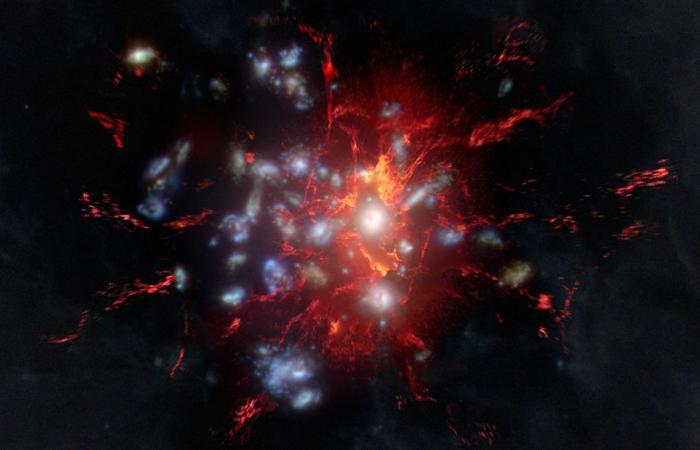
An important finding made with the Atacama Large Millimeter/Submillimeter (soul) and Atacama Pathfinder Experiment (Apex) radio telescopes revealed the existence of a huge diffuse molecular gas deposit in the Spru2349-56 galaxies protocumulum, a structure located more than 12,000 million light years of the earth. The study revealed that this mass of gas represents 75% more than previously detected, which extends the stellar formation period of these galaxies up to 400 million more years.
The researchers, when comparing the observations of the high -resolution configuration of souls with lower resolution of the compact array (ACA) Atacama of Alma and Apex, found a significant amount of molecular gas that was “invisible” in the images of soul with the highest resolution. Thus, 75% more than the sum of the individual sources detected in the largest soul data were detected.
In the investigation there are two Chileans contributing to this work: Manuel Aravena, researcher associated with Cata and Manuel Solimano, a doctoral student at our center, both in addition to Diego Portales University (UDP). Astronomers have also been important promoters of this study, including initial observations with Apex and the Australia Telescope Compact Array (ATCA). They are currently working with data obtained with the Band 1 of Alma, developed by Cata Engineers in the millimeter wave laboratory of the University of Chile to draw the diffuse gas reservoir in this system.
“The diffuse gas is almost always in clusters of very massive galaxies in the local universe, but not in the early universe. The second is that this gas is very high temperatures in the local clusters, which is compressed by the effect of the gravitational collapse of the cluster of galaxies, and therefore it is observed in X initials., ARAVENA explains, who also integrates the mingal nucleus.
Relevance of this gas in stellar formation and other studies
The study suggests that the temporary scale of global exhaustion will exceed 400 million years after this discovery. Which means that this can fall again inside the galaxies and act as fuel to feed the formation of new generations of stars for such a time.
Without that extra gas, the formation of stars in the individual galaxies would consume the one that each contains in a much smaller time. The researcher Cata states that after this investigation there are several edges to take into account. For now, “The obvious step is to try to see the distribution of such diffuse gas within the protocumulus, and consolidate the results (excess gas) with tracers of other phases of the gas”, Aravena emphasizes.
In relation to what was mentioned above by the astronomer, the team behind the study speculates that this extended gas could be the precursor of hot and diffuse gas known as intracumulum medium (ICM), which fills the clusters of mature galaxies. In this way, the discovery also offers a new perspective on how galactic clusters evolve, which are the largest structures in the universe, and understanding their training is one of the main objectives of scientists.
Aravena reveals this area as a long -term research work: “Most of the universe’s galaxies belong or belong to these structures, including our Milky Way. Although we have learned a lot in recent decades about the evolution of these structures, the role they have on a large scale is not yet understood in the intrinsic properties of each galaxy, how it affects its structure, its growth, and term of the formation of stars in this. This is one of the topics. tasting astronomers, as well as the millennium nucleus of galaxies (mingal) ”, The astronomer comments.





